Following a cross-drop error in January that led to at least 14 vehicles being accidentally filled with diesel instead of gasoline (or vice versa) in Avon, Ohio, another Circle K station has suffered the same issue – this time thousands of miles away in Phoenix, Arizona. At least 25 motorists were left with broken-down cars and heft repair bills following the mix-up. Though these seem to be one-off, isolated incidents, the statistics say it happens more often than you might think.
What is a “cross-drop”?
A cross-drop happens when the wrong type of fuel is pumped from a delivery truck into a storage tank, due either to unclear labeling or just human error. It’s a major headache when it happens, since the tank will need to be taken out of service until the contaminated fuel is cleaned up, knocking out the supply of at least one grade of fuel at the station.
What happens when you mix diesel and gasoline?
An internal combustion engine runs on tiny explosions, and gasoline and diesel combust differently. Of the two, gasoline is more volatile and explodes more readily. When gasoline is put into a diesel engine, premature combustion can occur, causing what’s commonly referred to as “engine knock”, and this will damage the engine over time. On the other hand, when diesel is put into a gas engine the engine will likely stop or stall because of the diesel not combusting. But that’s just one part of the problem.
Diesel is thicker than gasoline, which means it can can clog and damage a gas engine’s injection system and other components. Conversely, because gasoline lacks the lubricating quality of diesel, it can lead to premature wear of powertrain components. Everything the fuel touches, between the tank and the engine, and from the engine to the exhaust can and will be affected when the wrong type of fuel is used.
Big-ticket items on the repair bill include: engine, catalytic converter, fuel pump, and fuel injectors. And don’t forget the cost of labor – because whatever doesn’t get replaced will still need to be flushed out and cleaned. One of the Circle K customers affected by the mix-up was given a repair estimate of over $6,000.
This is the reason why fuel stations clearly distinguish their gas and diesel nozzles, whether it’s the color, the physical placement on either side of the pump, or a different nozzle diameter. But none of that helps if the problem is with the fuel itself.
What to do if this happens to you
If you haven’t started the vehicle yet – don’t! If you’re already underway, pull over as soon as possible and turn the engine off. Get a tow to a mechanic to have the fuel system flushed and inspected for damage. If you just filled up and you hear any unusual noises from the engine, see a warning light, or experience sudden loss of acceleration, stop the car. It might be tempting to limp to the nearest shop, but this can make the damage worse. It’s not worth risking $6,000 in repairs for a $60 tow.
If the fault falls on the gas station, as in these two cases, make sure to call the company’s customer support number. “We will help them through the claims process, including the necessary documentation. After reviewing and verifying the claim, we’ll reimburse customers for any repairs or associated costs related to this issue,” reads a statement from Circle K regarding the incident.
Cross-drops are more frequent than you might think
As one of the most expensive mistakes a gas station can experience, many safeguards have been established to prevent a cross-drop. But mistakes can and do happen – at a rate of one in 45,000 fuel drops. That’s less likely than Asteroid 2024 YR4 hitting Earth, and means that 99.998% of deliveries are completed without incident. But considering there are over 100,000 retail fuel stations in the US, with each receiving a few deliveries a week, the math says it happens about once, maybe twice a day, somewhere in the country; we simply don’t hear about them because they’re caught in time.

Leave a Reply